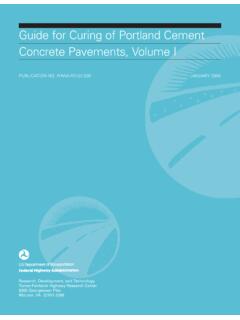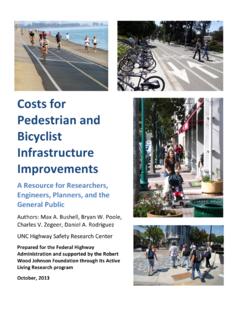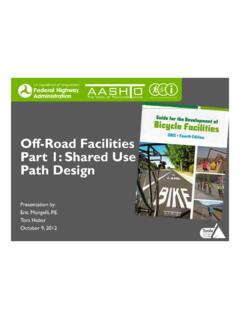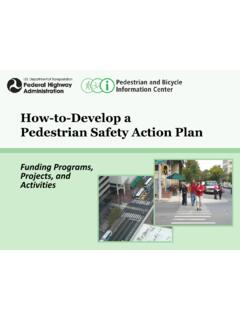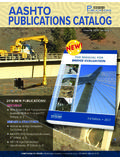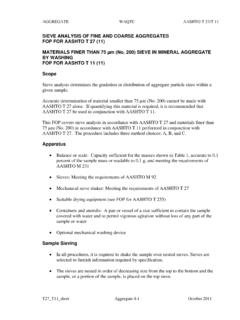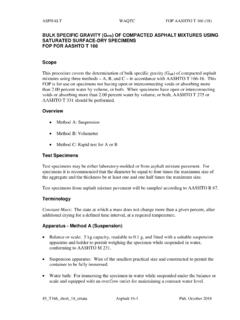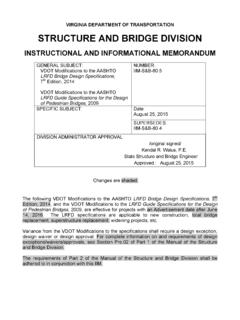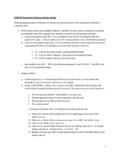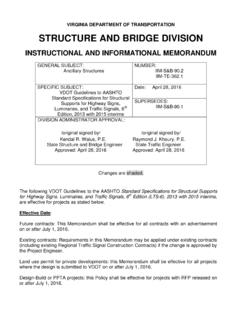Transcription of The 2012 AASHTO Bike Guide: An Overview
1 {Enter Module Name on Master Slide}The 2012 AASHTO bike guide : An OverviewPresentation by:Jennifer Toole, AICP, ASLAP eter LagerweyAugust 10, 2012 Overview of the 2012 AASHTO GuideWEBINAR #1: Overview OF 2012 AASHTO bike GUIDET oday s Webinar Some Background Major Content Changes Chapter by Chapter Intro to Content ChangesOverview of the 2012 AASHTO GuideFUTURE WEBINARS August 22: Planning Chapter September 4: On-Road Bikeways bike Lanes (including Intersections) September 18: On-Road Bikeways Shared lanes Bicycle boulevards & signing Signals October 9: Shared Use Paths General design principles Pathway geometry October 23: Shared Use Paths Intersection Design Mid-block crossings November 6: Bikeway Maintenance and OperationOverview of the 2012 AASHTO FOR WEBINAR PARTICIPANTSO verview of the 2012 AASHTO guide What is AASHTO ?
2 Mission: provides technical services to support states in their efforts to efficiently and safely move people and goods Some history 4thEdition of the guide Last guide 1999, largely written in 96-98 Standards vs. guidanceBACKGROUNDO verview of the 2012 AASHTO guide NCHRP - National Academy of Sciences Pre-Study Preparation of the content of the 4thEdition Final edits/State DOT balloting processHOW THE guide WAS DEVELOPEDO verview of the 2012 AASHTO GuideProject Team Toole Design Group Jennifer Toole Principal Investigator Subconsultants: John LaPlante, , PTOE Michael Moule, Michael Ronkin Mia Birk Matthew Ridgeway Shawn Turner, Srinivasa Sunkari, Bill HunterPREPARATION OF CONTENTNCHRP Panel Dwight Kingsbury, Chair Denise Chaplick David Church, Ann Do Eric Glick Thomas Huber Mary Meletiou Richard Moeur, William Prosser, William Riccio, Jr.
3 , Cara Seiderman Richard PainOverview of the 2012 AASHTO GuideHOW THE AASHTO bike guide IS USED State DOTs Basis for State Guides or Standards Local Jurisdictions Use State version of the AASHTO bike guide , or Develop own version of the AASHTO bike GuideOverview of the 2012 AASHTO guide Sold 1200 copies in the first month guide expanded from 75 pages to over 200 pages 3 chapters to 7 chaptersRELEASE OF THE guide JUNE 2012 Overview of the 2012 AASHTO guide 2009 MUTCD FHWA 2011 AASHTO Green Book Public Right-of-Way Accessibility Guidelines (PROWAG) 2010 Highway Capacity ManualRELATIONSHIP TO OTHER MANUALSO verview of the 2012 AASHTO guide AASHTO covers paths + on-road bikeways AASHTO covers design comprehensively AASHTO covers many but not all innovations NACTO is a source of information for solutions that are currently being testedAASHTO VS.
4 NACTO GUIDES: EITHER/OR? Overview of the 2012 AASHTO guide Guidance on how to choose bikeway type Affirms lane diets and road diets Expanded bike lane guidance Expanded signal guidance Expanded shared use path guidance (including paths adjacent to roads)MAJOR CHANGES IN 2012 GUIDEO verview of the 2012 AASHTO guide No differentiation of what type of bikeway was appropriate given roadway characteristicsCHOOSING BIKEWAY TYPE 1999 GUIDEO verview of the 2012 AASHTO guide Detailed guidance on facility selection. Support for bike lanes and shared use paths where volumes and speeds are BIKEWAY TYPE 2012 GUIDEO verview of the 2012 AASHTO guide Multiple warnings against using wide curb lanes as a standard solution for major roadways Discusses the appropriate use of shared lanes Wide curb lanes may have shared lane markings & signsCHOOSING BIKEWAY TYPE 2012 GUIDEO verview of the 2012 AASHTO guide Refers to Bicycle Level of Service as a tool Provides roadway characteristics to consider Also states that bike routes are not a bikeway type CHOOSING BIKEWAY TYPE 2012 GUIDEO verview of the 2012 AASHTO guide Permission to narrow lane
5 Widths to create bike lanes 10 and 11 wide travel lanes are acceptable Provides guidelines for road dietsLANE DIETS AND ROAD DIETSO verview of the 2012 AASHTO guide Nuanced guidance on widths (4 to 7 feet) Measures to reduce crashes with car doors bike lanes adjacent to back-in angle parking bike lanes at roundaboutsBIKE LANESO verview of the 2012 AASHTO guide Between the bike lane and parking lane or; Between the bike lane and the adjacent travel laneBUFFERED bike LANESO verview of the 2012 AASHTO guide Based on Interim Approval issued by FHWA in April 2011, contrasting green color pavement may be used in marked bike lanes, and in extensions of bike lanes through intersections and other traffic conflict areas, such as merge areas where turning vehicles must cross a through bike lane.
6 (p. 4-20)GREEN bike LANESO verview of the 2012 AASHTO GuideBACK-IN ANGLED PARKING bike lanes not recommended at front-in angle parking Provides design guidance for bike lanes at front of back-in angle parkingOverview of the 2012 AASHTO guide New guidance intersections, crossings and side paths Bollards are discouraged No single design speed 5% grade no landings (refer to US Access Bd.)SHARED USE PATHSO verview of the 2012 AASHTO guide Expands discussion of operational problems Acknowledges reasons for building paths adjacent to roadways Provides guidance on when and where these facilities are appropriate guidance considerationsPATHS ADJACENT TO ROADWAYSO verview of the 2012 AASHTO guide May be possible to place one-way paths on both sides of a roadway (type of cycle track)
7 Provides planning and design considerations ONE-WAY SIDEPATHSO verview of the 2012 AASHTO guide Should accommodate bicyclists New guidance on minimum green, extension time when bicyclist is present New formulas New information on bicycle detection Allows bicycle specific signalsSIGNALSO verview of the 2012 AASHTO guide New guidance explains what they are, and how they can be used to benefit bicyclists guide provides design treatments for creating bicycle boulevards BICYCLE BOULEVARDSO verview of the 2012 AASHTO GuideMAJOR CONTENT CHANGESI ntegrating Bikes with Transit bike access to transit vehicles bike parking at transit stations Bikeways to transit Promoting bikes on transitOverview of the 2012 AASHTO guide bike boxes Raised bike lanes Bicycle signal headsISSUES NOT ADDRESSED BY THIS GUIDEO verview of the 2012 AASHTO GuideTable of Contents 1: Introduction 2: Bicycle Planning 3: Bicycle Operation & Safety 4: Design of On-Road Facilities 5.
8 Design of Shared Use PathsCHAPTER BY CHAPTER INTRO TO CONTENT CHANGES 6: Bicycle Parking Facilities 7: Maintenance and OperationsOverview of the 2012 AASHTO guide Similar to previous guides Retains strong statement: All roads, streets, and highways, except those where bicyclists are legally prohibited, should be designed and constructed under the assumption that they will be used by bicyclists. CHAPTER 1 INTRODUCTIONO verview of the 2012 AASHTO guide Bicyclists need accommodation on ALL roadways Prioritize most important improvements Explains: The practical approach of network planning Choosing an appropriate facility type Multiple facilities on a single corridor WayfindingCHAPTER 2 BICYCLE PLANNINGO verview of the 2012 AASHTO guide Data collection.
9 bike counts Quality of service tools Safety analysis GIS-based network planning Bicycle travel demand analysis Cost benefit analysis Key role of public input CHAPTER 2 TECHNICAL ANALYSIS TOOLSO verview of the 2012 AASHTO guide Sets the stage for Design Chapters Organizes info on design vehicle Characteristics of Emerging Road and Trail Users (FHWA Study) Overview of traffic principles for bicycles Positioning on the roadway in different situations Causes of bicycle crashes Urban vs. rural Young vs. adult riders 3 BICYCLE OPERATION AND SAFETYO verview of the 2012 AASHTO GuideMost expanded section in AASHTO bike guide New/more guidance on bike lanes Buffered bike lanes Green bike lanes Nuance on width (4 to 7 ) Designs to reduce dooring Climbing lanes Complex intersectionsCHAPTER 4 DESIGN OF ON-STREET FACILITIESO verview of the 2012 AASHTO GuideCHAPTER 4 DESIGN OF ON-STREET FACILITIESNew sections Shared lane markings Where to use Placement Bicycle boulevards When and where to use Treatments Wayfinding signage Guidance on design & placement Deemphasizes bike routes (not a facility type)
10 Overview of the 2012 AASHTO GuideCHAPTER 4 DESIGN OF ON-STREET FACILITIESNew guidance on traffic signals Clearance intervals Minimum green time New Bicycle Signal Technical guidance on bike detection Special signal typesOverview of the 2012 AASHTO GuideCHAPTER 4 DESIGN OF ON-STREET FACILITIESNew/revised guidance Paved Shoulders (including rumble strips) Roadway Bridges Bicycles and Traffic Calming Bicycles on Freeways Bicycles at RoundaboutsOverview of the 2012 AASHTO guide New stand-alone chapter Reflects several significant studies: Characteristics of Emerging Trail and Roadway Users Shared Use Path Level of Service Safety Effects of Marked Versus Unmarked Crosswalks at Uncontrolled Locations Fills missing gaps in the old GuideCHAPTER 5 DESIGN OF SHARED USE PATHSO verview of the 2012 AASHTO GuideCHAPTER 5 DESIGN OF SHARED USE PATHS New Accessibility Requirements Width of Pathways Nuanced guidance on widths Safety Rail Guidelines Slopes/shoulders/railing heightsOverview of the 2012 AASHTO guide Revised Guidance on Design Speed No single design speed for paths Revised Guidance on Horizontal Alignment Formula is now based on lean angle rather than super elevation New
